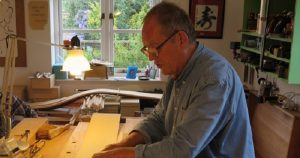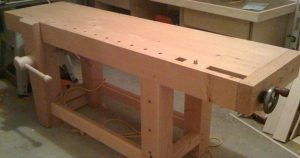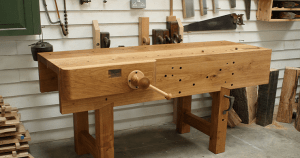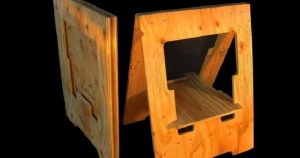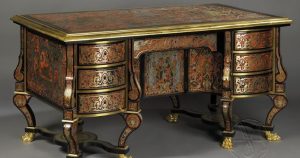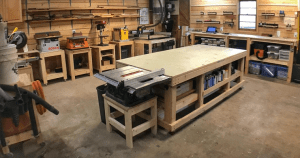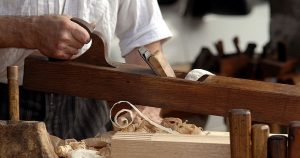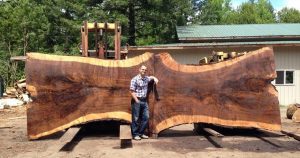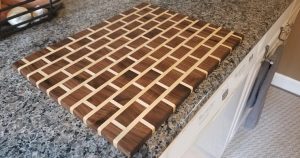David Binnington Savage passed away on Friday, January 18th, 2019. David will be remembered as a furniture maker who turned his workmanship into art. He was also an inspiration to his staff and everyone trained at the Rowden Atelier. Under his guidance, Rowden was transformed into the well-respected school. As he was fighting the illness, David never stopped working and he managed to publish his … [Read more...]
Summary Category
Wood Cures offers a summary on articles and posts on how working with wood and woodworking projects can cure the soul.
How to Make Workbench Dogs, Dog Holes & Holdfast Holes
Workbench dogs can help prevent items from slipping around on the bench as a workman shapes them. A wooden dog can go into the round dog holes easily, and they are easier to install than square metal ones. Additionally, round wooden dogs leave less of a print on wooden pieces. Dog holes can be made with a plunger router and a drill. For an added touch, workbench dogs can be shaped at the top to … [Read more...]
Foundations of Woodworking – Better Late Than Never
Going back to school is always difficult as you get older, but doing so for woodworking can sound implausible. It required financially commitment, but I knew Port Townsend School was where I wanted to learn the woodworking foundations. The reason I started that journey was the realization that I wanted to put my creative side to productive use. The school was the place where I can surround myself … [Read more...]
Garden Bench from Thermally Modified Ash
Thermally modified wood is typically used for decks. The process involves heating the wood in an oxygen free environment, which makes it stable, rot-resistant and darker in color. Three 12′ long 8/4 boards of thermally modified ash were used for this garden bench. The wood was cut with a bandsaw, with a chisel and oscillating sander used for clean up. Joinery is mortise and tenons. Finish prep … [Read more...]
The Butterfly Horse
The “Butterfly” is designed to overcome a lot of the problems with sawhorses. It is sturdy, lightweight and flexible. It folds and is one-and-a-half sawhorses in size. This project begins with a 60″ x 60″ sheet of plywood cut into four equal squares. Further cuts are needed to produce the butterfly "wings." Hinges and braces are utilized as well (the braces require a cold riveting process). The … [Read more...]
Quiet Book Club #3: Three Pieces, A Few Surprises
Only halfway into James Krenov's book do we get an idea of what it is about. He was a cabinetmaker as well as a writer. Krenov's first solo show was in 1965 in Stockholm, and it included pieces such as “Liv i Trä” and "Violin Cabinet." The latter of these shows the simple, almost rectilinear shaping from his early years. Another piece - “Chess Table” (1970) - displays Krenov's ability to show … [Read more...]
Shop Storage Solutions
Keeping the workshop clean and tidy is essential for being able to work at a fast, productive pace. Luckily the internet including finewoodworking.com has great articles for organization and similar pro tips. Learn how to build a rolling assembly cart from Jerry H. Lyons. A former Army woodworker Jason Stephens teaches us how to have an efficient portable tool storage system. Andy Beasley has … [Read more...]
Cabinetmaker?
Jonathan had been an accountant for 15 years. It wasn't really what he wanted to do with his life. He was jealous of people who had life figured out from the start. Once being introduced to furniture making his obsession grew and quickly Jonathan started his new career as a cabinet maker. He's now happy doing what he loves and feel like his work makes a real difference in his own life as well as … [Read more...]
Transforming Timber: Slicing a Walnut Log into 37 Slabs
A Masterclass in Precision Woodworking and Timber Utilization In the YouTube video "Slicing a Walnut Log into 37 Slabs," viewers are invited to witness the meticulous process of transforming a raw walnut log into 37 exquisite slabs. This engaging video showcases the art and science of woodworking, highlighting the use of a high-powered bandsaw mill to achieve perfect cuts and maximize the yield … [Read more...]
Brick Cutting Board Talk
My second end grain cutting board project used a brick pattern. The inspiration came from a cutting board seen at a craft fair. While cutting boards may not be terribly exciting projects, they are a good use of scrap wood and make great gifts. One important thing to keep in mind is that the pieces must have the same grain orientation lest the board crack over time. SketchUp was used to model each … [Read more...]
